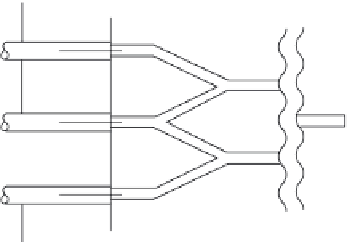Biomedical Engineering Reference
In-Depth Information
x
x
Fibers
Semiconductor chuck
Inputs
x
Output
x
Double—y
Mach-Zehnder
interferometer
Semiconductor
chuck with
fibers
FIGURE 5.19
Fiber input coupling using semiconductor chuck.
and a high-index waveguide. By embossing an unclad multimode plastic
(PMMA) fiber (
n
= 1.5) over a grating etched into a diffused LiNb
x
Ta
(1 −
x
)
3
waveguide (
n
= 2.195), they observed a 6% coupling efficiency. Their calcula-
tions indicated, however, that 86% efficiency should be obtainable with an
optimally blazed grating. Bulmer and Wilson [34] also used a grating to cou-
ple between a single mode fiber and a sputtered glass (Corning 7059) wave-
guide. In that case the fiber was heated and drawn to reduce the cladding
thickness to the point where coherent coupling through the overlapping
evanescent mode tails could occur. Again the observed coupling efficiency
was low (0.4%), but the authors calculate they could have obtained 30% effi-
ciency if they had used a fiber with a core diameter equal to the width of the
waveguide.
5.8.2 Waveguide to Fiber Coupling
Although the same limiting factors are relevant, butt coupling of light from
the waveguide to the fiber is an easier task than the converse because the
area of the fiber core is larger than the waveguide cross sectional area. In that
case a lens can be used to couple more of the light from the waveguide into
the fiber. By using a proper intervening lens the effective solid angle of col-
lection can be increased by a factor equal to the ratio of the area of the fiber
core to that of the waveguide. By using a cylindrical lens to better match the
rectangular waveguide mode to the circular fiber a coupling efficiency of at
least 50% should be obtainable [35].

















Search WWH ::

Custom Search